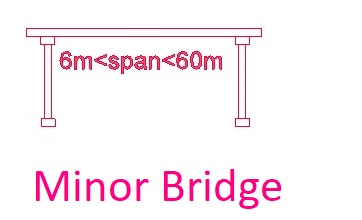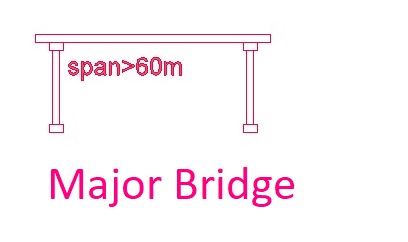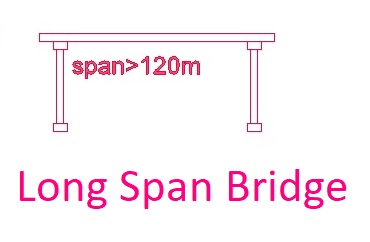In this blog article, I will describe the difference between Bridge and Culvert. The main work of the bridge is to permit the easy passage of traffic or community whereas the culvert is constructed for the passage of water.
Table of Contents
What Is Bridge?
The bridge is a drainage structure that serves as a communication route for carrying a road or railway traffic across an obstruction or depression with or without water.
The path of communication may be a railway, roadway, cycle track, footpath, or a combination of both of them, and the obstruction may be in the form of a river, stream, valley, channel, road, railway track, etc.
Minor Bridge:
The bridge has an overall span length greater than 6 meters & less than 60 meters.

Major Bridge:
The bridge has an overall span length greater than 60 meters.

Long Span Bridge:
Major Bridge has a main span length of more than 120 meters.

What Is Culvert?
A small bridge having a total length of 6 m or less between the faces of abutments is called a culvert.
These are permanent drainage structures that are chiefly constructed to carry roadway or railway track over small streams or canals.

Difference Between Bridge And Culvert
- The bridge is constructed to permit the easy passage of traffic or community whereas the culvert is made for the passage of water.
- The length of a bridge is always more than 6 meters, but the length of a culvert is 6 meters or less than 6 meters.
- Bridge normally constructed over an obstruction, or depression or freeway, roadway, railway, etc, the culvert is constructed over small streams or canals.
- The culvert is generally rectangular or circular in cross-section, having a roof, walls, and a floor. The bridge sits on the foundation of each bank and it does not have a floor.
Here are the table comparing differences between bridge and culvert.
| Criteria | Bridge | Culvert |
|---|---|---|
| Purpose | To span a gap, such as a river, road, or railway | To allow water to flow under a roadway, railway or embankment |
| Design | Generally longer and wider than culverts | Generally shorter and narrower than bridges |
| Span | Can span long distances, sometimes kilometers | Can only span relatively short distances |
| Height | Typically higher off the ground than culverts | Typically lower to the ground than bridges |
| Load-bearing capacity | Designed to carry heavy loads, such as vehicles or trains | Designed to carry lighter loads, such as water or pedestrians |
| Construction | Typically more complex and expensive to build | Typically simpler and less expensive to build |
| Materials | Can be constructed from a wide variety of materials, including concrete, steel, wood, and stone | Typically constructed from concrete or steel |
| Cost | Generally more expensive than culverts | Generally less expensive than bridges |
| Maintenance | Requires more frequent maintenance than culverts due to its larger size and complexity | Requires less frequent maintenance than bridges due to its smaller size |
| Visibility | More visible and prominent than culverts, often considered a landmark | Often hidden from view and less noticeable than bridges |
| Traffic | Bridges allow for continuous traffic flow | Culverts may require the temporary closure of roads or railways during maintenance |
| Location | Typically located in areas with high traffic volume, such as cities or major highways | Typically located in rural areas or areas with lower traffic volume |
| Length | Can be very long, spanning kilometers or even miles | Relatively short, generally less than 20 meters |
| Water flow | Bridges do not restrict the flow of water, but may cause erosion or alter the natural flow of the river | Culverts allow water to flow underneath the roadway, railway or embankment, maintaining the natural flow of water |
| Type | There are many different types of bridges, including arch, suspension, and cable-stayed bridges | There are two main types of culverts: box culverts and round culverts |
| Purpose | Used for transportation of goods and people | Used primarily for drainage purposes |
| Approach | Bridges typically have approach ramps to connect with the road or railway | Culverts typically do not have approach ramps, as they are embedded into the ground |
| Environmental impact | Bridges may have a significant impact on the environment, especially if they alter the natural flow of a river | Culverts generally have a lower impact on the environment than bridges |
| Noise | Bridges may generate noise from traffic passing over them | Culverts generally do not generate noise |
| Flood protection | Bridges may help to protect against flooding by allowing water to flow under them | Culverts can help to prevent flooding by allowing water to flow away from roadways or railways |
| Maintenance cost | Maintenance of bridges can be more expensive due to their size and complexity | Maintenance of culverts is generally less expensive than bridges |
| Durability | Bridges are generally more durable than culverts due to their larger size and stronger construction materials | Culverts are generally less durable than bridges |
| Appearance | Bridges are often considered aesthetically pleasing and can be architectural wonders | Culverts are generally not considered attractive and are often hidden from view |
| Width | Bridges are generally wider than culverts, allowing for multiple lanes of traffic | Culverts are generally narrower than bridges |
| Accessibility | Bridges are typically more accessible to pedestrians and vehicles than culverts | Culverts are typically less accessible to pedestrians and vehicles |
| Land use | Bridges may require significant land use for approach ramps and other infrastructure | Culverts typically require less land use than bridges |
| Flow rate | Bridges do not restrict the flow of water, but may cause changes in the water’s flow rate | Culverts generally do not cause significant changes in the flow rate of water. |
| Elevation | Bridges are generally elevated structures that span over the ground or water surface | Culverts are generally embedded in the ground or waterway |
| Longevity | Bridges are designed to last for decades or even centuries | Culverts have a shorter lifespan compared to bridges |
| Traffic capacity | Bridges can accommodate heavy traffic loads such as trains, buses, and heavy trucks | Culverts are typically designed to accommodate light traffic such as pedestrians, bicycles, and small vehicles |
These are some of the key differences between bridges and culverts. It is important to note that the specific characteristics of a bridge or culvert will vary depending on its design, purpose, location, and materials used in construction
Conclusion
These are the key differences between bridge and culvert. Engineers and designers must have knowledge of these differences to avoid any mistake in the design of bridge or culvert.
